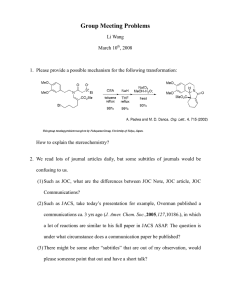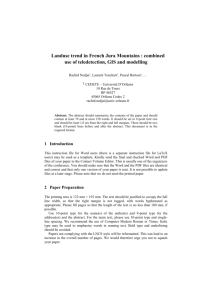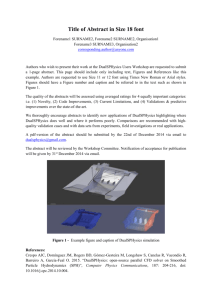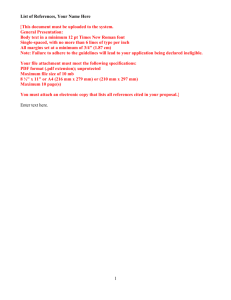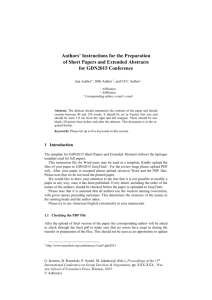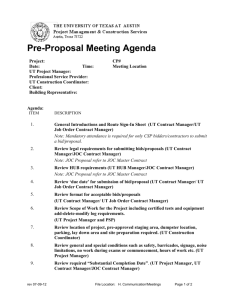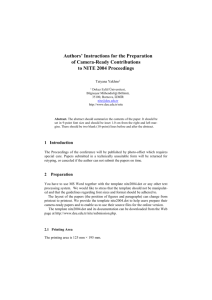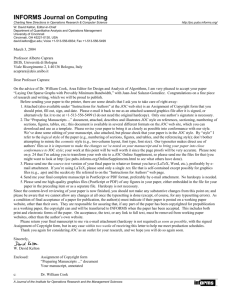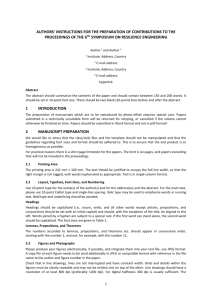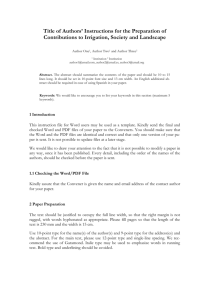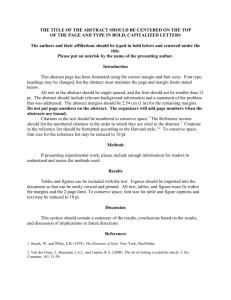paper_format_download
advertisement
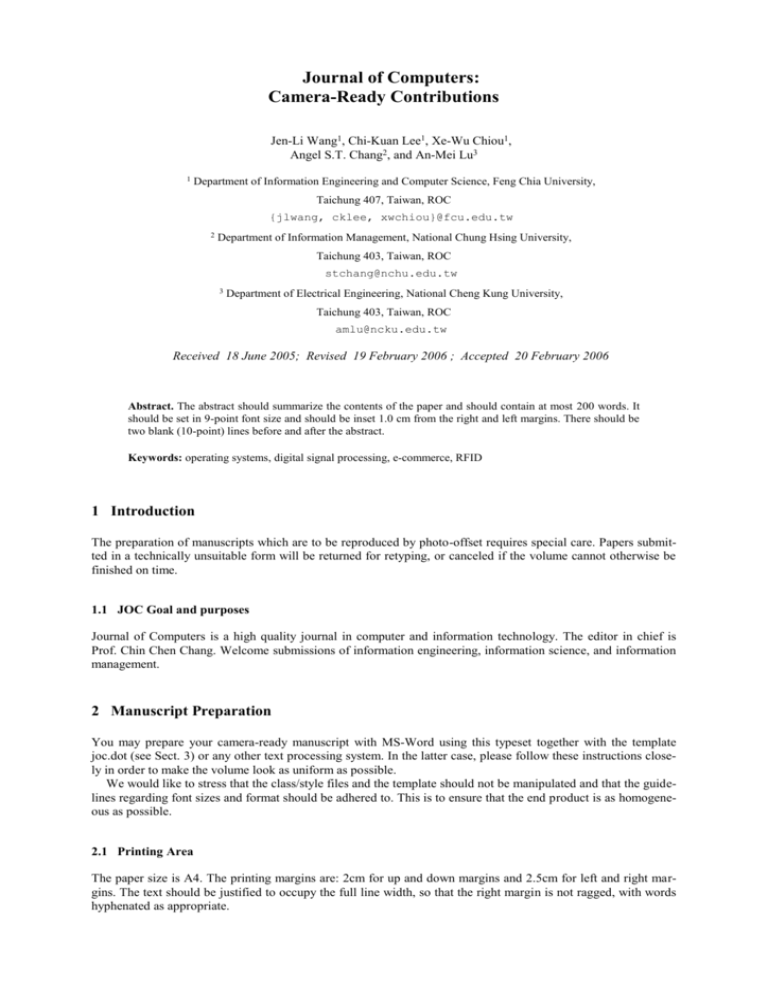
Journal of Computers:
Camera-Ready Contributions
Jen-Li Wang1, Chi-Kuan Lee1, Xe-Wu Chiou1,
Angel S.T. Chang2, and An-Mei Lu3
1
Department of Information Engineering and Computer Science, Feng Chia University,
Taichung 407, Taiwan, ROC
{jlwang, cklee, xwchiou}@fcu.edu.tw
2
Department of Information Management, National Chung Hsing University,
Taichung 403, Taiwan, ROC
stchang@nchu.edu.tw
3
Department of Electrical Engineering, National Cheng Kung University,
Taichung 403, Taiwan, ROC
amlu@ncku.edu.tw
Received 18 June 2005; Revised 19 February 2006 ; Accepted 20 February 2006
Abstract. The abstract should summarize the contents of the paper and should contain at most 200 words. It
should be set in 9-point font size and should be inset 1.0 cm from the right and left margins. There should be
two blank (10-point) lines before and after the abstract.
Keywords: operating systems, digital signal processing, e-commerce, RFID
1 Introduction
The preparation of manuscripts which are to be reproduced by photo-offset requires special care. Papers submitted in a technically unsuitable form will be returned for retyping, or canceled if the volume cannot otherwise be
finished on time.
1.1 JOC Goal and purposes
Journal of Computers is a high quality journal in computer and information technology. The editor in chief is
Prof. Chin Chen Chang. Welcome submissions of information engineering, information science, and information
management.
2 Manuscript Preparation
You may prepare your camera-ready manuscript with MS-Word using this typeset together with the template
joc.dot (see Sect. 3) or any other text processing system. In the latter case, please follow these instructions closely in order to make the volume look as uniform as possible.
We would like to stress that the class/style files and the template should not be manipulated and that the guidelines regarding font sizes and format should be adhered to. This is to ensure that the end product is as homogeneous as possible.
2.1 Printing Area
The paper size is A4. The printing margins are: 2cm for up and down margins and 2.5cm for left and right margins. The text should be justified to occupy the full line width, so that the right margin is not ragged, with words
hyphenated as appropriate.
Journal of Computers Vol.XX, No.XX, July 2007
2.2 Layout, Typeface, Font Sizes, and Numbering
Use 10-point type for the name(s) of the author(s) and 9-point type for the address(es) and the abstract. For the
main text, please use 10-point type and single-line spacing. We recommend using Computer Modern Roman
(CM) fonts, Times, or one of the similar typefaces widely used in photo-typesetting. (In these typefaces the letters
have serifs, i.e., short endstrokes at the head and the foot of letters.) Italic type may be used to emphasize words
in running text. Bold type and underlining should be avoided. With these sizes, the interline distance should be
set so that some 45 lines occur on a full-text page.
Headings. Headings should be capitalized (i.e., nouns, verbs, and all other words except articles, prepositions,
and conjunctions should be set with an initial capital) and should, with the exception of the title, be aligned to the
left. Words joined by a hyphen are subject to a special rule. If the first word can stand alone, the second word
should be capitalized. The font sizes are given in Table 1.
Here are some examples of headings: "Criteria to Disprove Context-Freeness of Collage Languages", "On
Correcting the Intrusion of Tracing Non-deterministic Programs by Software", "A User-Friendly and Extendable
Data Distribution System", "Multi-flip Networks: Parallelizing GenSAT", "Self-determinations of Man".
Lemmas, Propositions, and Theorems. The numbers accorded to lemmas, propositions, and theorems etc.
should appear in consecutive order, starting with the number 1, and not, for example, with the number 11.
Table 1. Font sizes of headings. Table captions should always be positioned above and center the tables.
The final sentence of a table caption should end without a period
Heading level
Title (centered)
Example
1st-level heading
2nd-level heading
3rd-level heading
4th-level heading
1 Introduction
Journal of Computers …
2.1 Printing Area
Headings. Text follows …
Remark. Text follows …
Font size and style
14 point, bold
12 point, bold
10 point, bold
10 point, bold
10 point, italic
2.3 Figures and Photographs
Please produce your figures electronically, if possible, and integrate them into your text file. Check that in line
drawings, lines are not interrupted and have constant width. Grids and details within the figures must be clearly
readable and may not be written one on top of the other. Line drawings should have a resolution of at least 600
dpi (preferably 1200 dpi). For digital halftones 300 dpi is usually sufficient. The lettering in figures should have a
height of 2 mm (10-point type). Figures should be scaled up or down accordingly. Please do not use any absolute
coordinates in figures. If possible, the files of figures (e.g. PS files) should not contain binary data, but be saved
in ASCII format.
If you cannot provide your figures electronically, paste originals into the manuscript and center them between
the margins. For halftone figures (photos), please forward high-contrast glossy prints and mark the space in the
text as well as the back of the photos clearly, so that there can be no doubt about where or which way up they
should be placed.
Figures should be numbered and should have a caption which should always be positioned under the figures,
in contrast to the caption belonging to a table, which should always appear above the table. The final sentence of
a caption, be it for a table or a figure, should end without a period. Please center the captions between the margins and set them in 9-point type (Fig. 1 shows an example). The distance between text and figure should be
about 8 mm, the distance between figure and caption about 5 mm.
Remark 1. In the printed volumes, illustrations are generally black and white (halftones), and only in exceptional
cases, and if the author is prepared to cover the extra cost for color reproduction, are color pictures accepted. If
color illustrations are necessary, please send us color-separated files if possible. Color pictures are welcome in
the electronic version at no additional cost.
2
Wang et al: Journal of Computers_Camera-Ready Contributions
P
P0
P’0
P0
P1
P1
P2
P’1
P’2
Pm-2
Pm-1 Pm-1
P’m-1
P’
Fig. 1. Circuit for computing P’(x)
Remark 2. To ensure that the reproduction of your illustrations is of reasonable quality we advise against the use
of shading. The contrast should be as pronounced as possible. This particularly applies for screenshots.
2.4 Formulas
Displayed equations or formulas are centered and set on a separate line (with an extra line or halfline space above
and below). Displayed expressions should be numbered for reference. The numbers should be consecutive within
each section or within the contribution, with numbers enclosed in parentheses and set on the right margin. For
example,
a+b=c.
(1)
Please punctuate a displayed equation in the same way as ordinary text but with a small space before the end
punctuation.
2.5 Program Code
Program listings or program commands in the text are normally set in typewriter font, e.g., CMTT10 or Courier.
Example is a Computer Program.
program mutiplication (parameter_1, Parameter_2, Output)
{Assuming user is a junior student};
const Times = 9;
var
i, j, mul: Integer;
begin
i := 0;
j := 0;
WriteLn('This is a 9 x 9 example'); WriteLn;
3
Journal of Computers Vol.XX, No.XX, July 2007
repeat
i := i + 1;
repeat
j := j + 1;
mul := I * j;
WriteLn(i:5, ’*’, j:5, ‘=’, mul:5)
until (j=9)
until (i=9)
end.
2.6 Footnotes
The superscript numeral used to refer to a footnote appears in the text either directly after the word to be discussed or – in relation to a phrase or a sentence – following the punctuation sign (comma, semicolon, or period).
Footnotes should appear at the bottom of the normal text area, with a line of about 5cm in Word set immediately
above them.1
2.7 Citations
The list of references is headed “References” and is not assigned a number in the decimal system of headings.
The list should be set in small print (of size 9) and placed at the end of your contribution, in front of the appendix,
if one exists. Please do not insert a pagebreak before the list of references if the page is not completely filled. An
example is given at the end of this information sheet. For citations in the text please use square brackets and
consecutive numbers: [1], [2], [3], …
2.8 Page Numbering and Running Heads
Your paper should show no printed page numbers; these are allocated by the volume editor. Please indicate the
ordering of your pages by numbering the sheets in pencil at the bottom of the reverse side. Do not set running
heads.
2.9 Printing Quality
For reproduction we need sheets which are printed on one side only. Please use a high-resolution printer, preferably a laser printer with at least 300 dpi. We prefer the text to be centered on the pages (i.e., equal margins left
and right and top and bottom). The format of the paper (A4, Letter, etc.) is irrelevant.
3 Using MS Word
We do not encourage the use of MS Word, particularly as the layout of the papers (the position of figures and
paragraphs) can change from printout to printout. Having said this, we do provide the template joc.dot to help
MS Word users prepare their camera-ready manuscript and to enable us to use their source files for the online
version.
The template joc.dot and its documentation can be downloaded from the JOC Web page at
ftp:\\140.134.26.80\joc\JOC Format (English)\joc.dot .
4 Acknowledgement
The authors may express their acknowledgement and the financial support project number here.
1
4
The footnote numeral is set flush left and the text follows with the usual word spacing. Second and subsequent lines are
indented. Footnotes should end with a period.
Wang et al: Journal of Computers_Camera-Ready Contributions
References
[1] C.T. Lee, J.M. Lin, B.Y. Lin, "Building Complete Call Graphs for Linux Function Points," in Proceedings of 2005 International Conference on Open Source Technology, pp.68-74., 2005
[2] J.M. Lin, Z.W. Hong, K.M. Fang, H. J. Jiau, W.C. Chu, "Reengineering Windows Software Applications Into Reusable
CORBA Objects ," Information and Software Technology, Vol. 46, pp. 403-413, 2004.
[3] E.R. McLean and J.V. Soden, Strategic Planning for MIS, John Wiley, New York, 1997.
Appendix: JOC-Author Benefit
The appendix should appear directly after the references, and not on a new page
All authors of JOC, in particular authors contributing to JOC volume, are entitled to get a volume of journal
when this issue published.
5
